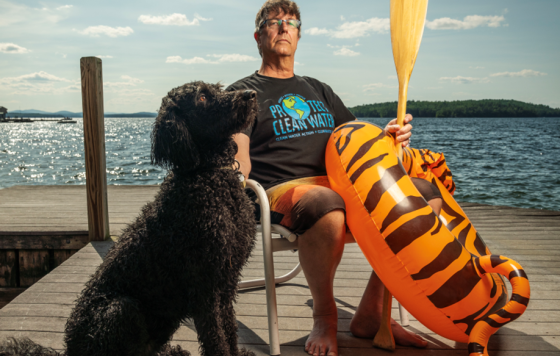
I have written or edited many articles over the years about toxic algae. But now, I’ve had my own first-hand experience. And now, this is way more than just another dirty water story to me.
Just before the July 4th holiday, when I glimpsed news headlines about toxic algae in New Hampshire’s largest lake, Lake Winnipesaukee, I didn’t bother reading about the details. I assumed it was a problem happening somewhere far away from the quiet cove where I’ve spent so many summers with family and friends. Surely this was something affecting the more heavily developed areas, the handful of cities and towns around the lake.
The algae I’m talking about is the vile green stuff that grows in water when it gets too much food under the wrong combination of weather and temperature conditions. Some varieties, known as cyanobacteria, can be highly toxic to humans and animals. You don’t even need to drink the stuff – simply coming in contact with it through swimming or even spray blown by the wind can cause all kinds of harmful health effects.
This time of year, we often see lots of tree pollen floating in the water – yucky looking but harmless. Little did I know that, this time, mixed in with all that pollen were deadly strands and particles of a cyanobacteria “bloom” taking place way out in the open water. It had been blown into the cove and up against the shore by the prevailing winds, where it was accumulating to dangerous levels.
I found out the hard way, after my dog, Wooly, spent a few minutes playing in the water and drinking some of it. For the next few days, he struggled with severe vomiting and diarrhea. Wooly could have died, and there was literally almost nothing we could have done about it.
Soon thereafter, while he was still very sick, I learned that the state had issued cyanobacteria warnings for the part of the lake where this all happened. That’s how we found out what had happened. Many people around Lake Winnipesaukee still use water from the lake for drinking, cooking and bathing (in addition to swimming, boating and other recreation). But when it comes to toxic cyanobacteria, most home water filtration or UV (ultraviolet) treatment systems can’t make this water safe. Boiling doesn’t work either. The only safe approach is to stay out of the water and to avoid its use for cooking, cleaning, bathing and drinking (this includes ice cubes from a lake water-supplied refrigerator icemaker).
But toxic algal blooms and cyanobacteria outbreaks don’t just happen. They can almost always be traced to human activity. Wastewater from sewage treatment plants, or leaks and overflows from failed septic systems can be sources of the Phosphorus pollution that fuels these outbreaks. But in a sparsely settled area well away from municipal sewage plants, chemical fertilizers from waterfront lawns can be a much bigger factor. Lake Winnipesaukee, like many relatively pristine lakes and ponds nationwide, has seen explosive growth in high-end waterfront development – multi-million dollar homes that come with expectations for large, “perfect” lawns running right down to the water.
Clean Water Action’s work to ban phosphate in laundry and dishwashing detergents has made a big difference reducing the role sewage and septic pollution can play in fueling dangerous cyanobacteria blooms. This is a prime example of pollution prevention in action, one of which we can all be very proud.
But this other source – artificial landscaping, sweeping waterfront lawns with little or no natural buffer of trees or shrubs between lawn and water, and the chemicals that make these kinds of landscapes possible – is entirely preventable. Our changing climate with more and more periods of extreme heat, extreme drought and extreme rainfall combines with these artificial landscapes and chemical lawn fertilizers to make a bad situation much, much worse.
In the case of my dog, Wooly, the bad situation could well have been fatal. Anecdotal reports of pet fatalities from cyanobacteria exposure are on the rise nationwide. Fortunately, in our case, Wooly is now fully recovered after a few very scary days.
Here are some steps I believe should be taken, starting immediately to prevent this kind of pollution from getting even worse in the coming months and years:
- Developers and homeowners (not just those right on the waterfront) should stop insisting upon the kinds of lawns you can only get through intensive use of harmful chemical fertilizers and pesticides.
- Owners of waterfront properties should leave sizeable un-mowed buffer strips – shrubs, trees, wildflowers – between those properties and the water which makes them so valuable and desired.
- State and local environmental and health agencies must do a better job enforcing laws to protect vulnerable waterfronts and limit destructive shoreline over-development.
- Where government lacks the authority, resources or political will to protect our water, people who care about clean water must come together to demand it.
- When we support clean energy and climate solutions, we’re also supporting solutions that create jobs and protect clean water.
Congress must fix the Clean Water Act so that small streams, wetlands – and ultimately the water we (and our beloved pets) drink and use for recreation – are once again protected under the law. But we can’t wait for Congress to act. We must also demand action from our state and local governments who can shoulder this responsibility and fill dangerous gaps in protection, while we organize for national solutions.
I'm grateful that Wooly is no longer in danger. Here we are after the near-death experience as we prepare to enjoy a swim in clean water.
If this sounds like a clean water agenda you can get behind, make a gift to Clean Water Action today. This is our priority. It’s what we do. And we can’t do it without you!
DONATE
Click here to learn more about nutrient pollution (nitrogen and phosphorous) and our drinking water.



